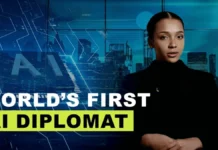In the early days of digital diplomacy, MFAs and diplomats viewed social media as linear communication tools. Diplomats believed that they could use social media to craft a message and directly disseminate it among online publics. Thus, social media was no different from other mass media such as the radio and television.
Yet as the practice of digital diplomacy evolved diplomats began to view social media as non-linear communication tools. This stemmed from a deeper understating of social media algorithms and their ability to prevent a diplomatic actor from reaching his target audience. Indeed an MFA could only disseminate messages among his followers and his followers’ followers. The understanding that algorithms fracture the linearity of social media promoted diplomats to employ new strategies for message dissemination. These included piggy-backing on trending hashtags, replying to popular Tweets, mapping and cultivating relationships with online influencers and collaborating with individual social media users in peer-to-peer activities.
Notably, MFAs and diplomats became aware of algorithmic barriers following consular crises. Such was the case in 2014 when MFAs attempted to contact citizens stranded in Nepal following a devastating earthquake. Within hours of the quake, MFAs were asking their followers to “Share” emergency contact numbers and notify the MFA of loved ones who may be in Nepal.
Nowadays MFAs view social media as consisting of hundreds of echo chambers, or filter bubbles that must be fractured if messages are to reach their intended audience. The Israeli MFA, for instance, is attempting to fracture echo-chambers of hate speech while the UK Foreign Office is attempting to burst filter bubbles of Daesh supporters.
It is, however, possible that the view of social media as non-linear communication tools is no longer sufficient as social media feeds are tailored to the unique characteristics of individual users. This suggests that diplomatic messages will appear differently in each user’s feed and that, subsequently, digital diplomacy is really personalized diplomacy. The question that follows is can MFAs control the manner in which their messages are received online?
On Cats and Dogs
Social media such as Twitter and Facebook use extremely sophisticated algorithms to tailor one’s online experience. Such algorithms take into account a host of variables ranging from a user’s stated interests to the type of content he shares online, the issues and subject matters he “Likes” or “favourites” and even the amount of time he spends watching videos of dog rescue teams. These variables, which are updated in real time, are used to determine the user’s feed or the stream of Tweets and Posts he is exposed to on social media.
What follows is that digital diplomacy messages will appear in different locations in each user’s feed. While one user might begin his Twitter scroll with Justin Trudeau’s Diwali greeting, another would view the greeting after watching a dog being rescued in London. In this case, both users are likely to experience Trudeau’s message in a similar fashion. But what about a Tweet by President Trump promising to use “fire and fury” against North Korea? A user who views this Tweet upon logging on to Twitter may conclude that the Korean crisis will soon escalate to war. A user who views this Tweet after a video of cats playing the piano might assume that these are the rumblings of a mad President. Crucially, both users would ascribe different importance to Trump’s Tweet and even interpret the Korean crisis in a different manner.
Given that MFAs and diplomats now use social media to narrate and frame their foreign policies, the location of digital diplomacy messages in users’ feeds may prove an important factor in online communication. The Psychological theory of Priming demonstrates just how important a Twitter feed may be.
Priming Diplomacy
Simply put, priming theory postulates that exposure to a certain stimulus may determine how an individual reacts to another stimulus or another situation. Priming theory assumes a connection between an individual’s memory, emotion and data processing. For instance, some words have been found to elicit feelings of empathy or anger. Brief and unconscious exposure to these words can influence an individual’s decision making process. A person may be more likely to harshly judge another after being exposed to words that elicit anger or to take a more lenient approach if exposed to words that elicit sympathy. Visual stimuli can also impact cognitive processes. Some studies have exposed participants to brief and unconscious images of Swastikas. These participants were then asked to make judgments about Israel’s security policies. According to these studies, people were more likely to express pro-Israel sentiments if exposed Swastikas.
Within the realm of digital diplomacy, it is possible that Twitter and Facebook feeds have a priming effect on digital messaging. Positive and negative stimuli may influence how social media users evaluate and engage with MFA messages. Thus, a Tweet appearing after a dog rescue may be viewed more positively than a Tweet viewed after violent images or images of starvation in another country. It is also possible that users’ evaluation of a Tweet’s content may be influenced by stimuli. For example, social media users in a positive mind-set may be willing to accept an MFA’s interpretation of events in Syria while users in a negative mind-set might reject it.
The intersection between priming and social media could therefore suggest that digital diplomacy has been personalized and that MFAs’ ability to manage social media messaging is quite limited. This assertion is strengthened when one takes into account the assemblage of visual stimuli we are exposed to on social media including ads, information on trending topics, trending hashtags and promotional content. Each of these can have a priming effect and alter one’s appraisal and interaction with digital diplomacy content.
MFAs and diplomats may therefore need to find new ways to counter the priming effects of social media streams.
The Personalization of Digital Diplomacy













